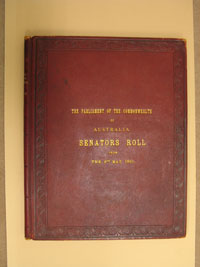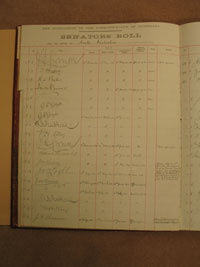45 Roll
-
A senators’ roll for each state and territory shall be kept by the Clerk, showing the names of the senators, the dates of election, of taking the oath or affirmation of allegiance, of ceasing to be a senator and the cause.
-
Each senator shall sign the roll on the day on which the senator takes the oath or affirmation of allegiance.
-
When senators have been divided into 2 classes under the provisions of section 13 of the Constitution, the Clerk shall enter on the roll opposite the name of each senator the class to which the senator belongs.
Amendment history
Adopted: 19 August 1903 as SO 41 (corresponding to paragraphs (1) and (2)) and SO 42 (corresponding to paragraph (3))
1989 revision: Old SOs 42 and 43 combined into one, restructured as three paragraphs and renumbered as SO 45; some simplification and clarification of expression; a reference to territories included in paragraph (1) and a reference to the President in paragraph (3) replaced with a reference to the Clerk for consistency with paragraph (1)
Commentary

The Senators' Roll is a large format ledger

The Senators' Roll contains the signatures of all senators sworn in since 1901
The Senators’ Roll is one of two rolls signed by each senator at the time of his or her swearing in. The other is the Test Roll. Section 42 of the Constitution requires every senator before taking his or her seat to make and subscribe before the Governor-General, or a person authorised by him or her, an oath or affirmation of allegiance in the form set out in the Schedule to the Constitution. The Test Roll is a record of this. It is also signed by the person who administers the oath or affirmation of allegiance. When new and re-elected senators are sworn on the first sitting day after their terms begin on 1 July, the Governor-General (or the Administrator), or a Deputy authorised by the Governor-General, performs this function because there is no President in office.
The Governor-General gives any newly-elected President of the Senate an ongoing commission to administer the oath or affirmation.[1] Acting under this authority, the President usually administers the oath or affirmation to new senators chosen to fill casual vacancies and those elected to represent the territories. The terms of territory senators begin and end on polling day for elections for the House of Representatives; they are sworn on the first day of a new parliament after an election.
The Senators’ Roll is a record of information required to be kept by SO 45, including, for each state and territory, the names of senators, the dates of election, of taking the oath or affirmation, of ceasing to be a senator and the cause. The roll also records which of the two classes a senator belongs to for the purpose of the rotation of senators under s.13 of the Constitution. Senators were divided into two classes after the first election in 1901 and after each double dissolution election to establish which senators would serve three year terms and which senators would serve the full six year terms. See Odgers’ Australian Senate Practice, 14th edition, for commentary on the method for dividing senators into two classes.
The roll itself is a large format journal with a tooled leather binding and marbled endpapers. The first volume spanned from 9 May 1901 until June 2002 and was divided into sections for each state. When the territories gained Senate representation in 1974, Tasmania sacrificed some of its pages at the end of the volume to record details of the territory senators’ terms. The new volume has sections for the two territories as well as the six states.